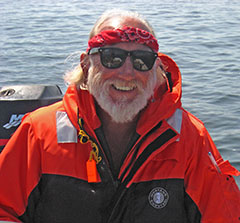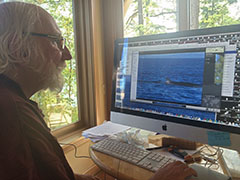Dr. S. Jonathan Stern
By Frances "Frankie" Robertson
Dr. Jonathan Stern, a marine ecologist and leading marine mammal expert, died on 16 February 2017, just 62 years young. He was a long-standing researcher at the UW Friday Harbor Labs and a professor in the Department of Biology at San Francisco State University.
 Jon searching for minke whales from an FHL boat in 2008. Photo: Frankie Robertson.
Jon searching for minke whales from an FHL boat in 2008. Photo: Frankie Robertson.
Jon, as most knew him, was born in 1955 and grew up in San Rafael, California, just north of San Francisco. His interest in whales was sparked by an eventful encounter between a sperm whale and his father’s ship, the SS Lurline, somewhere off the coast of New Zealand. His work with marine mammals began with the rehabilitation of seals and sea lions at The Marine Mammal Center in Sausalito, California, where he was the very first volunteer when it opened in 1975.
Jon earned his BA in Biology from Sonoma State University (SSU) in 1980 where he took invertebrate natural history from his undergraduate advisor, Friday-Harbor-trained Colin Hermans, who encourage Jon to study invertebrates, not whales. When he graduated, Dr. Hermans told Jon about the new whale museum that had just opened near Spring Street in Friday Harbor. Jon went straight there and got a job caring for the invertebrate display tanks at FHL, thanks to the invertebrate course he had taken at SSU. More importantly, Jon joined the ambitious study of the minke whales of Puget Sound begun by Eleanor Dorsey at the Whale Museum.
 Rus Hoelzel (left) and Jon Stern in 1980. Photo: Laura Norris.
Rus Hoelzel (left) and Jon Stern in 1980. Photo: Laura Norris.In 1984, Jon began a parallel study of minke whales in Monterey Bay, research that earned him his M.A. from San Francisco State University. He went on to complete his doctorate at Texas A&M University where he expanded his interest in marine top predators and spatio-temporal movement patterns. Jon first taught at Texas A&M, and later in 2006 he joined the biology department at San Francisco State University, where he became a much-loved lecturer, inspiring mentor, and confidant of students and colleagues.
Jon’s interest in the role of marine predators in ocean ecosystems led him to study many other cetacean species over the years including fin, humpback, gray, pilot and killer whales, bottlenose dolphins and most recently harbor porpoises. But he always returned to the Friday Harbor Labs to continue his studies of minke whales.
The minke whale project is the longest running longitudinal study of the species. It was also the first study to apply photo-id techniques to a baleen whale — now a common research tool. But Jon’s main interest lay in the animals’ foraging ecology and particularly the search strategies that these animals used to find their prey patches. Through his ability to track individual minke whales, Jon was able to analyze their movement patterns in the context of optimal foraging strategies. Minke whales appeared to maximize the number of sites with potential feeding patches they were able to visit by adopting a Lévy flight search strategy.
 Jon working on photo-ID data at FHL's Whiteley Center in 2016. Photo: Frankie Robertson.
Jon working on photo-ID data at FHL's Whiteley Center in 2016. Photo: Frankie Robertson.
Jon was a tremendous champion of the minke whale, and those of us who study the species have come to think about minkes in a different way because of his research. Jon argued that minkes are not simply the small cousins of the mighty blue whale. They are ecologically very different, and we should appreciate them on their own terms. Thus, what began as a thesis project for a Master's degree at SSU became Jon's life work on these often-underappreciated little whales.
In 2008, Jon made an important discovery in San Francisco Bay: after a complete absence of more than 60 years, harbor porpoises had returned to reoccupy the Bay on a daily year-round basis. He considered this a good-news environmental story that should be shared and studied. To that end, he co-founded Golden Gate Cetacean Research, a non-profit organization devoted to conducting research on the local harbor porpoises (another underappreciated species). Over the years, this work expanded to include studies of the coastal bottlenose dolphin population and the recent phenomenon of humpback whales feeding in San Francisco Bay.
Jon was not only a gifted scientist and teacher, he was also a man of great class, a gentle man with a generous desire to share his knowledge and his enthusiasm for scientific enquiry with anyone lucky enough to encounter him. Meeting other researchers and learning new cool ideas was one of his great joys. He was a talented musician with an appreciation for good music and beautiful guitars. He was an integral member of the Blowhole Blues Band, and for the last few years played with his band The Jungle Studs. He had a soft spot for pugs, particularly his own pug Robert, who often accompanied him to class.
Jon was many things to many people; scientist, teacher, mentor, friend. To many he was all these things and more. But regardless of what one’s connection to Jon was, his loss will leave a profound mark on all who knew him. Jon’s ashes were scattered in San Francisco Bay near his favorite place from which to watch harbor porpoise: Cavallo Point, with a view of the Golden Gate Bridge in the background. Jon is survived by his sister Kitsy and her family, Duncan Haldane, and many many friends and colleagues all over the world.



